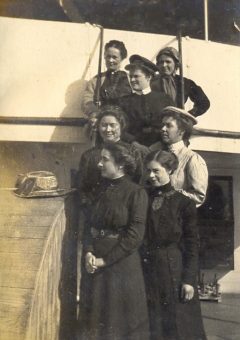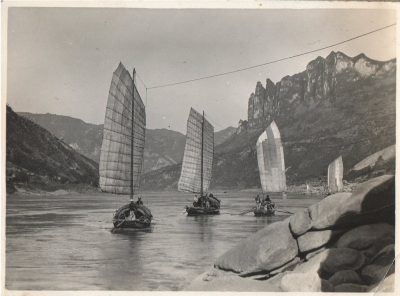Episode 5 is part of Listening Through the Archives, Stories from the CDCC.
By Meredith Boerchers
Foreground
Allow me to introduce you to Marion Coon.
Traces of Miss Coon’s life linger at large in the CDCC today. An entire branch of the United Church Women’s group is named in her honour. Though her name continues 80 years after her death, the only information to be found about Marion Coon in the archives is in the form of three obituaries. Painfully brief, these works tell readers just enough to whet the appetite: Marion Coon, daughter of the Reverend Coon at Dominion Methodist Church, left Canada in 1920 to work as a missionary in West China for 16 years, before sickness overtook her during a furlough in 1938.
Although it seems that Coon was well-loved overseas and in Canada—so much so that her home-church established a Marion Coon Mission Circle to support missionary work— there aren’t any other records of her life at CDCC. The United Church Archives of Canada in Toronto similarly has one small file on Coon containing a list of her postings in China and basic bio-data. Beyond that, the only other publications mentioning Miss Coon are two student theses written about other missionaries, and a post about her farewell party in an old newspaper.
My suspicion is that the letters sent from Miss Coon to her church in Canada were burned in Dominion Church’s 1961 fire. With just a basic sketch of her lifework, how can we learn more about the woman who has left a legacy but no details?
Allow me to (attempt to) introduce you to Miss Coon through the stories of others, and the story of a nation in upheaval.
Background

New Missionaries for the Women’s Missionary Society, 1910
Marion Coon was born and raised in Ottawa, Canada. After attending Normal School and teaching in public schools for 2 years, in 1920 Miss Coon decided to bid her home country adieu and travel to West China to join a Mission set up in Chongqing (alternatively spelled Chungking, Qongqing).
Coon’s decision to leave the familiarity of Canada in favour of the mysteries of China may well surprise contemporary readers. In the early decades of the 20th century, however, waves upon waves of missionaries similarly departed for the distant shore. In 1888, the Presbyterian Church of Canada sent out its first group of missionaries to China. As strangers to many of the rural Chinese population, these Canadians were met with “an atmosphere of curiosity, suspicion, superstition, fear, and open opposition” (Song 1993, 10). However, within in a few short decades the number of missionaries in China exploded from 19 in 1901, to 218 in West China alone in 1925. The workers in West China opened ten central stations, one hundred outstations, more than one hundred and fifty schools, and a university. In total, over 500 missionaries worked and lived in the country during the 60-year period of missionary labor.
What could draw these immense numbers in such a short time? What about China drew the attention of Marion Coon?
The exodus of Protestant missionaries to China from 1860 to 1960 can be seen as the result of several interconnected factors. The revival of evangelical fervor in the late nineteenth century, called the Third Great Awakening, included a strong concern for social justice, and many Christians felt led to work in places in need of humanitarian aid. Years of political unrest in China had left the civic needs of many Chinese unattended, thus the country became a popular destination for missionaries with training in medicine, dentistry, and education.
As a young, unmarried woman, it is likely that Marion Coon was familiar with the recruitment materials of organizations like the Young People’s Forward Movement. In order to entice young people to work overseas, YPFM and the like used lantern slides and audiovisual material to showcase pictures of China and spark the young people’s imaginations. A collection of lantern slides can be found in Carleton University’s library holdings today—they colourfully depict China’s landscape, exotic buildings, and Chinese cultural practices. Although there are no records of Miss Coon attending such recruitment meetings, this model was so popular that it is not hard to imagine that Marion—the daughter of a reverend—would have encountered enlistment imagery.
Familiar at least with the country’s beauty, one wonders if Miss Coon also knew about the dangers of working as a Canadian missionary in China. Nineteen years before her arrival, Chinese missionaries and Chinese Christians became the victims of wide-scale looting, arson, and murder during the Boxer Uprising of 1900. A decade later, revolutionaries overthrew the Qing dynasty but struggled to establish a strong, central government. With the central government struggling to define itself and maintain control over the large country, several local warlords declared themselves separate from China, leading to an era of regionalism lasting from 1911 to 1927.
Still, the unrest in China must not have phased Miss Coon, as she sailed off to Sichuan province in 1920 and didn’t return for 7 years. Her experiences in China at this time have to be left to the imagination, though we can piece some clues together from the records left by other missionaries. To travel to the city of Chongqing, missionaries often sailed up the Yangtze river on “junks”—Chinese sailing crafts in use since the 2nd century AD. If river travel was unsuitable, wheelbarrows and sedans could also be hired to carry travellers over land to their destinations.

Junks on the Yangtse River. (Credit: UoT Library)
Upon her arrival in Chongqing, Miss Coon helped to build a girls’ school before becoming its principal. According to the missionary Mrs E. S. Strachan of Hamilton, missionaries to China needed to be “architects, master masons, carpenters and painters, as well as teachers, physicians, nurses and musicians.” The school was named the Wende (Wen Deh) Girls’ Middle School. Here, Miss Coon worked with young women and girls, teaching a variety of subjects including Christian religion. The only requirement for enrollment was that the student’s feet be unbound. While this practice was regarded as inhumane by the missionaries, this requirement also intersected with the broad renegotiation of Chinese identity and values brought on by the growing New Culture Movement. This Chinese intellectual-led movement pushed China to turn away from “traditional” codes of morality and culture based in Confucianism, and to embrace elements of Western culture—science and democracy being the most prominent. Foot binding became one of the practices that members of the New Culture Movement targeted.
In 1927, Miss Coon returned to Canada for a furlough. While none of her obituaries give the reason for this timing, this return coincides with the forced evacuation of many Canadian missionaries from the Sichuan province. The year previous, 1926, the Nationalist and Communist Chinese forces briefly allied to embark on a military campaign that would sweep the country and create a unified China, free of warlord rule. The Northern Expedition Force lasted for 2 years, and in 1927 the missionaries were advised to leave Sichuan due to an increase in anti-foreigner sentiment and insecurity created by the presence of Nationalist soldiers.
Marion spent the next two years in Canada. Keen to keep working, she first went on a lecture tour through Ontario, then travelled to Saskatchewan to teach at a school in Assiniboine. It seems, however, that her homeland held little attraction. Miss Coon returned to West China in 1931, again to work in schools in Leshan (then called Kiating) and Chongking. However, the China she returned to was not the one she left. According to the writings of WMS worker Mary Lamb, Sichuan had transformed over the past decade. River travel had evolved to include steamers, and the dramatic scenery of the Yangtze had become a tourist attraction. Moreover, in the aftermath of the Northern Expedition, travelling on the river was suddenly much safer. Gone were the days of skirmishes between regional Chinese warlords and anti-foreign demonstrations. Chongking, too, was a city transformed. The New Life Movement had continued to grow within the city’s culture, and many modernizations had been introduced by the wealthy population. This, however, created a noticeable disparity between the lives of the missionaries, who were installing electric lights in the Mission, and the poor population. Miss Lamb wrote “This city of Chungking [sic] is a city of contrasts, terrible slum conditions and much wealth. Quite a lot of motor cars on some streets and sedan chairs and rickshas all mixed up together.”
It seems that Marion Coon’s position as a foreign missionary had transformed into a position of some respect rather than suspicion. When the leader of the Republic of China, Chiang Kai-Shek came to visit Chongking in 1935, his wife, Madame Chiang, asked to be introduced to the missionaries. While Chiang Kai-Shek was a practicing Buddhist, his wife was a Christian, and desired to meet fellow Christians in all the cities that she visited. Miss Marion Coon joined one other medical missionary, Mrs. Gentry, to form a welcoming committee that would greet the visitor and see to her needs throughout her visit.
For all the social transformations in Sichuan that likely made Miss Coon’s work easier, there was little that could be done when a severe drought led to a season of devastating famine throughout the province in 1936. Miss Coon left China once more—though whether it was due to the famine or another reason, we do not know. Her return to Canada could well have been for her own health. In July 1937, Miss Coon became so ill that she was unable to return to China in the following season, as she had planned. This illness ultimately led to her death the following summer, in 1938.
Frame
This excursion into the scenery of Marion’s life demonstrates that hers is a story of struggles, triumphs, and adventures. However, these events are not what her friend, Annie Ward, chose to remember Marion by in a published memorial. It was Miss Coon’s “quiet efficiency, soundness of judgement, and her willingness to undertake the task given to her, however difficult it might be” that Ward treasured and passed on to future readers. Her serenity, “always there was about her a serenity which came from her inner faith and strength of spirit, and which inspired confidence in those with whom she lived and worked.” In the years since her death, Marion Coon is remembered best not for the work that she accomplished, but for the kindness, gentleness, and resilience of her character. And though her life was short and its written record has not been maintained by an official archive, Marion Coon’s legacy continues to stand through the years. It echoes through the lives of women like Danke Li, who went to school in Wende and today shares publicly about the experiences of China during the War of Resistance. It’s seen in the women of Dominion-Chalmers, whose same concern for physical, social, and spiritual well-being lead them into organizing and supporting relief work in their home communities, just as it lead Marion Coon to afar away country. While her stories may have faded, her heart for those in need has not.
Photo Collections
John William Foster Fonds Lantern Slides (Archives & Special Collections)
Research Resources
- Shulman, Deborah. 2008. “Prisms of China: Canadian Women Missionaries in China, 1904-1945.” Doctoral Dissertation: Concordia University.
- Song, Zhuoying. 1993. “A Study of Three Women Missionaries of The United Church of Canada, from the Maritime Provinces to Sichuan, China, 1933-1953.” Masters Thesis: Saint Mary’s University.
- Vic in China. 2015. “Chronology.” University of Toronto, online exhibition.
- Obituaries in the CDCC archives (no publication information)